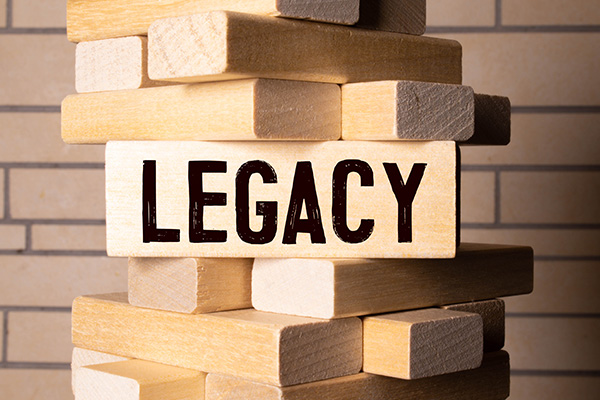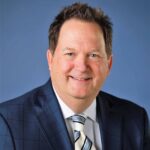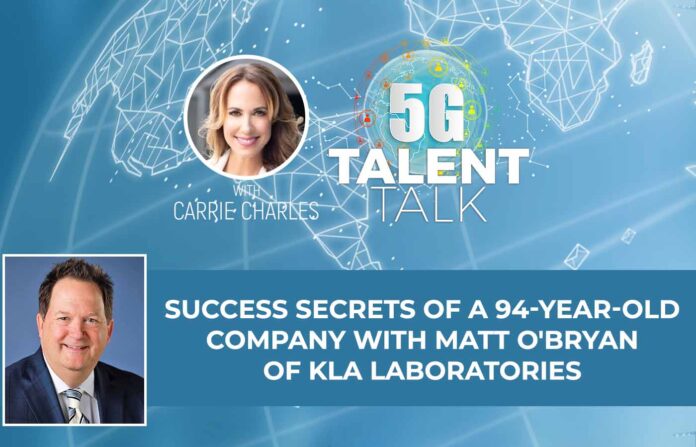In a world where startups dominate the headlines, there’s something remarkable about a company that boasts a 94-year-old history. How has KLA Laboratories managed to not just survive but thrive for nearly a century?
In today’s episode of 5G Talent Talk, Carrie Charles is joined by Matt O’Bryan, President and CEO of KLA Laboratories, a projects and services company integrating technology solutions for networks, premise cabling, operational technology, the internet of things, wireless networks, collaboration, audio/video, and event production.
In this interview, Matt O’Bryan shares with us how KLA Laboratories adapts and innovates in this rapidly changing industry. He discusses the importance of building long-term relationships with customers and focusing on customer satisfaction and service. Matt shares insight on KLA’s commitment to their employees and the local community with an emphasis on growth, development, mentorship and diversity in the workplace.
Tune in to learn the leadership principles and strategies that have kept this family-owned business thriving for almost a century.
—
Watch the episode here
Listen to the podcast here
Success Secrets of a 94-Year-Old Company with Matt O’Bryan of KLA Laboratories
In this episode, I have a special guest with me, Matt O’Bryan. He is the President and CEO of KLA Laboratories. Matt, thanks for joining me. I am super excited about this discussion.
Carrie, thanks for having me on.
Matt, I met you years ago. We’ve stayed in touch a bit. I was always so impressed by your journey and story. I’m excited to get into that as well as talk about KLA. Can you talk about how you got to where you are in your seat?
KLA is a company that originated in 1929 in Detroit, Michigan as an audio company. If you think about audio and technology in 1929, it was advanced technology when they started building microphones and speakers because they could present an event and everyone could hear. It wasn’t just yelling loud.
We had this new technology. It was the three founders: K, L, and A, who were friends, got together, and started this company. My father was in World War II. He was a radio specialist and happened to run into an employee at KLA in 1947. He said, “We’re looking for new talent. Come on down. We’re hiring.” My dad went there and interviewed the founders of the company. He was hired on the spot. My dad was an amazing man and very dynamic. Everybody loved him. He lit up a room when he walked in. You’ll love the guy. It was obvious why he got picked.
That was in 1947. Fast forward, he told my mom, whom he was dating at the time, “I’m going to buy that company someday. When I have enough money, those guys are going to be old enough to want to retire, and I’m going to buy them out.” He was true to his word. He started buying stock in the company in the ‘50s. In the ‘60s, we had controlling interests. That’s how the O’Bryan family got into KLA. I’ve never worked anywhere else. I grew up in the company. I’m the youngest of six kids. We all worked at KLA at some point. In a family business, that’s what you do.
I formally started when I was sixteen there in shipping and receiving. I worked through every different area of the company. In 1991, my father passed away suddenly. He had lung cancer and six months later, he passed. It became a turning point in all of our lives in our family. My mom who had never worked in the company has this company and three of us siblings were working in the company. We had to make a decision, “Do we keep the company going? What do we do?”
I hadn’t planned on working at KLA full-time. I was in college. That was the fork in the road of life. I wanted to be a golf pro. I was a good golfer and played in college. I thought that’s what I want to do. It sounded like a great plan. This was a family called and this is what happened. It’s been the greatest thing for me. It turned out that I’ve had a wonderful career. I’ve worked through sales and engineering and have been running the company for the past solid years as the president and CEO.
My mom is still with us and doing great. She’s still my boss, technically. It’s fun too. I’ll go over and see her and she’s like, “How are things at work?” It’s still important to her to find out how things are going. I’m like, “They’re going great, mom. Everything’s good. We’re doing well.” That’s a long story but that’s how I got to where I am. Here I am at KLA years later and have never worked anywhere else.
Not a lot of people can say that. That is an incredible history and journey to get to where you are at KLA. How does this longevity benefit customers and employees?
We still have clients that we’ve had for entire years. Ford Motor Company, we have gone for them for many years. The history of the company and the way that the original founders ran the company and my dad had his version of the company was instilled in me. It was a successful company for many years before I came along. I was taught how the company was successful in the past. This is how to take it into the future and keep it going.
A part of the company has to be relevant. You have to reinvent yourself a lot. We joke internally. We’re an old startup because we always have to think of where we want the company to be and go. That’s a startup mentality. We have to be looking at where we want KLA in several years. Through my tenure, we’ve gone in a lot of different directions and expanded our service offerings to our customers. It doesn’t necessarily mean we look for new customers. We do but we also want to be more relevant to our existing client base.
A company always has to be relevant, inventing and reinventing itself a lot.
What are your service offerings? Let’s go a little deeper here. What do you offer? What problems do you solve? Whom do you serve?
Large enterprise clients. We’re doing work in manufacturing spaces, stadiums, arenas, convention centers and data centers. We offer a whole gamut of systems integration and technology integration in local area networks, Wi-Fi, DAS networks and audiovisual solutions. We do all the infrastructure to support all that. We design the network. We install the cabling, the fiber and the copper cabling for that network. We deploy all the switches and Wi-Fi access points or DAS antennas. We commission them and do ongoing monitoring and maintenance of it all.
We’re a full turnkey shop of all of that. We do it all in-house essentially. We’re headquartered in Michigan. We have an office in Las Vegas and we opened in Irvine, California but we work across the country. We have boots on the ground in Canada, Mexico and throughout the US. We do deploy globally too so we have projects going on in India and different areas in Europe.
From a cultural standpoint, how has your culture evolved over the years? Tell us what it’s like to work for KLA now.
I’ll go back to what I talked about when they laid out how they had this great company and built it. I mentioned to you when we met that we have union personnel, IBEW third generation. Their grandpa worked at KLA before my dad started there and then their dad. Grandpa worked 40 years at the company. Dad worked 40 years at the company. 2 of them are almost 40 years in 2023, and that’s a union position.
Normally, they can go to another company easily. It isn’t normal for people to work at one company their entire career in the field. We have that at that level. It’s a family business and it still has that family feel. A lot of people like that because everyone’s important. If someone is struggling in an area, people will step in and help them out. We’re all in this together. You would help a sibling out if they needed help. It’s that thing and that’s a big key to our culture and longevity.
In a company, everyone should be important. If someone is struggling, people should step in and help them out.
Many companies say, “We have a family culture.” Companies are struggling because there are employees and team members that aren’t even staying for 1 year or 2 years. We’re challenged with retention and quiet quitting. There are all these buzzwords that we need to worry about as leaders. What is your retention rate? It’s got to be amazing. It’s high.
I don’t know. I can’t give you an exact number. Not that I’m not concerned because it is the world we live in. We’ve been doing this for a long time. Before, there were retention issues. KLA is such a diverse company, what our serving offerings are and where we do our work. You could be working in a stadium one day and in a manufacturing plant the next day, a hotel or a hospital.
If somebody’s in an area and they see what we do in another area, we are very clear that they have opportunities for career growth and they can move around in the company. You can job jump inside KLA without leaving. We’ve been doing that for a very long time. That is another key to our retention rate, I would say.
Are there strong relationships within the company? I’m fascinated by this because we’re all struggling with this as entrepreneurs and companies. Retention is a huge problem. Can you give us maybe one other strategy or another part of your secret sauce to the retention and that strong culture you’ve built?
It’s having regular meetings and discussions and meeting with people early on in their careers. We have this internship program that we’re going to talk about in a bit. These interns come in and they put in important roles in the company. They’re learning things right out of the gate. Part of that is we foster that culture. We try to get people to get exposed to a lot of different things.
The secret to retention is having regular meetings with people early on in their careers.
They’re like, “That’s cool. I like where I work and what I do. This is interesting. I don’t know where I’m going to be tomorrow. I might be on a different site.” You always feel like it’s not the same thing every single day. You don’t wake up and do the same thing. That was something that I loved about the company when I was a kid because I didn’t know where I was going to go the next day. You get to work. You’re driving here and going there. It’s always been that way and that’s key to why it still works.
Let’s go a little deeper into the internship program. How does that work? What feeds that program?
I’m a graduate of Henry Ford College. It’s a local college here in Dearborn. We have a Cisco Academy. We partner with the Cisco Academy to start this internship program and it went well. We have gotten some rock stars from our company who have come in as interns. We have 34 people that are full-time in careers at KLA that came through that program in the last several years. We started a scholarship program. We endowed a KLA technology scholarship at Henry Ford College. It’s specific to the Cisco Academy.
They can apply for the scholarship and as part of that, they get a paid internship at KLA. That’s the door opening and them getting in, looking and seeing what they may like and want to pursue a career at KLA. That’s how that all began. When we talked to those interns early on, we are very careful to talk to them about what their long-term goals could be of them. If you bring someone in who either is finishing up college and tell them this is what the possibility could be, it makes them feel that maybe that’s a good plan for them. For the most part, it works out.

How do you identify and develop leaders? It’s clear that you are committed to growth and development and that’s a huge priority for our young people. How do you take someone through that process of developing leaders? Succession is a big priority because you want to be around another 100 years, I’m sure, or maybe 500.
I’m good with 500. That’s pretty solid. I have a great leadership team. These are very seasoned people. They either came from other industries or they came up through the ranks at KLA. We’ve always done a lot of mentoring, coaching and job shadowing. There is a lot of communication that happens at departmental leadership levels with the team. Having that dialogue at that level helps people get a better feel for what goes on in the company beyond what they see in their purview, essentially. Leaders, as they go through the ranks, raise. We want to see that, help grow that and cultivate that. That would be some of the keys to how we develop our internal leadership.
Everything you’re saying is what the younger generations are asking for, which is not only growth and development but mentorship, the ability to grow and experience different things within a company versus going outside of it. This is great stuff. I could rewind this and take so many notes. I know that you’re also committed to creating a diverse inclusive workforce and environment. How do you do that at KLA?
The wonderful thing about KLA is it has always fostered a culture of diversity in our workforce historically. As society has changed in recent years, it was important for us to formalize our DEI initiatives, implement programs around that and make a statement. We have instituted policies and formal training around it.
It’s very important to me. The great thing is it didn’t take much for us to implement these initiatives. I’m very proud that we pulled together a team within KLA of diverse individuals. People are our greatest asset. It’s important that people feel that they work in a safe environment and they can be their true selves. That’s what we feel and has always been the case at KLA.
What about ESG? Any initiatives here? What are your thoughts?
As part of some of these training programs, we looked at our policies around ESG. We’re doing quarterly training. We’re looking at our policies and procurement, how can we be greener and a lot of different things. Also, incorporating those different considerations around ESG.
Matt, I saw you at an Entrepreneur of The Year event and I know that you were a winner of Entrepreneur of The Year in the past. I want to ask you, as an entrepreneur, what would you do differently if you had it to do all over again like if you were sitting many years ago and said, “I can change something or do something different?” I want to look at the key elements of your success here.
I don’t know that I would do anything different having thought about this but I would’ve loved for it to have happened more quickly. I don’t think I made any mistakes in what I was doing. I had a dream and the vision to grow the company and take us into different areas. I still believe in what I believed. I wish you want success quicker. I’m very proud of what we’ve accomplished and where the company is and where it’s going.
I wouldn’t necessarily change what I was doing or do it differently but the key element to the success and what we’ve done is I had a dream. I came up with an idea like, “Let’s do this.” I would talk to my leadership and listen to what they would say. Sometimes they say, “That’s a crazy idea.” If they say, “I’m doing my job. We can’t do that,” I’m like, “That’s good. Let’s figure out how.” Be creative around that and figure out how to do it.
What drives you?
I’m carrying on a legacy of a company that’s been ingrained into my family for generations. We’ve come a long way in my era at the company. There’s more to do and it excites me. I wake up and there’s technology. Where things are going to go in the future is what keeps me interested in what I do every single day.

What’s your vision for 2023? What’s next? Maybe even 500, we could create that.
In 2023, we’re going to continue some of the great progress we made in 2022. It was a difficult year with some of the supply chain issues but a lot of that is eased up. 2022 was a good year. I’m looking forward to continuing our growth both regionally, our expansion out West and some of our new clients and carrying that vision into the next years. We always have to stay at the forefront of technology. As things change and new technology comes out, we want to make sure that we’re leaders in that and continue that technological growth in those service offerings to our clients.
Matt, I want to ask you a personal question as our final question and I hope you don’t mind sharing. You’re a leukemia survivor. I’m curious. How did this change the company and yourself?
In 2000, I was diagnosed with hairy cell leukemia. The company was going well and growing. All of a sudden, I hit a stop sign and had to go in and be treated in the hospital. I was out of work. I was in the hospital for three months and worked through that. There’s a wonderful thing about KLA as I spoke about our leadership and how it’s always been. Tommy Cataldo, who’s our Chief Operating Officer, stepped up to run the company. My mom was still at the company but she had to take care of me and make sure I survived ultimately.
Tommy took care of things at the office while I was out. It changed my perspective on life. I took things less seriously because life is short. We’re all getting through this pandemic. We’ve all had a life-changing and eye-opening experience. I had that at that time. I came back. Since then, I’ve been involved with the Leukemia & Lymphoma Society. I’ve been on the board since 2004. We host a golf outing every year to raise money for leukemia research.
I’m super passionate about it. The drug that treated me and saved my life was funded by the Leukemia Society. It’s super close to my heart and I’m tied to the cause. 2023 will be our tenth anniversary. We’ve raised over $350,000 that’s gone to the Leukemia Society for research. I’m very fortunate to be as healthy as I am and a survivor. This was so obvious that I need to give back and help. That’s my story on leukemia.
Matt, you are such an inspiration. I can feel the heart in KLA. It’s inspiring to me as I listen to all of these different points that you’ve made, how you’ve become successful, and how KLA has been successful for so many years. It all hits home. It’s everything that we’re reading about like the people-first culture, how to give people a voice and allow people to grow, develop and have the flexibility and the opportunity to be themselves and trust them. Everything you’ve said is exactly where we need to be and every company needs to be. I want to thank you for coming to the show. This has been fantastic. I appreciate you sharing your heart and being authentic.
Thank you, Carrie. I appreciate you inviting me. This has been great.
Lastly, how can we reach you? How can we find out more about KLA and your open jobs? I’m sure you’re hiring.
KLALabs.com and there’s a career tab on there so you can take a look and see our openings across the country.
Thanks for coming to the show.
Thanks, Carrie.
Take care.
You too.
Important Links
About Matt O’Bryan

“I commit myself every day to my father Pat O’Bryan’s memory, progressively taking KLA to heights he could never have imagined while proudly serving our clients with the honesty, integrity and passion he instilled in our family.”
The 94-year-old heart of KLA Laboratories continues to beat strong at every client job site, with every technological advancement, and inside every dedicated employee as Matt O’Bryan, youngest son of Norma and the late Pat O’Bryan, fervently forges innovative new paths with his entire team at the global communications technology company.
Matt began working at KLA in 1984 at age 16 in the shipping and receiving department and became an audio/visual technician after high school graduation. Though Matt had been unsure about his life’s direction, his career path crystallized when his father, then KLA President Pat O’Bryan, passed away suddenly in 1991. His mother, Norma, took over as President and Matt was named Vice President of Operations while still in college, earning his Bachelor of Business Administration from Cleary University in 1992.
Ten years later, in 2002, Matt was promoted to President and CEO as Norma sold her interest in KLA to Matt, her son Donald, and her daughter Mary. As a second-generation owner, Matt began expanding the company’s product and service offerings, and KLA’s annual revenue soared from $2.5 million that year to $11.9 million in 2005.
Matt’s vision and strength as a leader were both solidified when the company’s market share and profits dropped to dangerously low levels as the recession began to hit in 2007. Laser-focused on KLA’s future, the company began selling, engineering, and installing network hardware for the cabling and Wi-Fi networks they built. KLA created a Network Services Division and Network Staging Center and established expertise in cellular in-building wireless Distributed Antenna Systems (DAS). These new offerings further expanded and reinforced KLA’s reputation as a leader in technology integration and led to great growth and rising revenues, reaching $40 million in 2022.
At the beginning of 2022, Matt became the sole owner of KLA as Donald and Mary O’Bryan retired from the company after careers of 44 years and 35 years, respectively.
Matt now leads an ever-growing team of approximately 200 employees across North America, and KLA has expanded its reach to provide services globally. Every team member feels a part of the KLA family. Collaboration and the freedom to create, grow, and learn from mistakes are a big part of the corporate culture Matt has continued to strengthen throughout his tenure.
In 2000, Matt was diagnosed and treated for Hairy Cell Leukemia and has been in remission since 2008. Surviving Leukemia inspired Matt to help others. Since 2004, Matt has served as a Trustee on the board of the Michigan Chapter of the Leukemia & Lymphoma Society and has raised over $350,000 to fund research to find a cure for blood cancer.Matt was honored as one of Crain’s Detroit Business 40 Under 40 class in 2007. In 2018, Matt received the EY Entrepreneur Of The Year® Award in the Technology category for the Michigan and Northwest Ohio Region.
One of Matt’s personal passions is playing guitar, songwriting, singing, and performing regionally with his country-rock band, The Wrenfields. They have released three critically acclaimed albums of original music, won six Detroit Music Awards, and are releasing their 4th album entitled “The Wrenfields” in July 2023.

